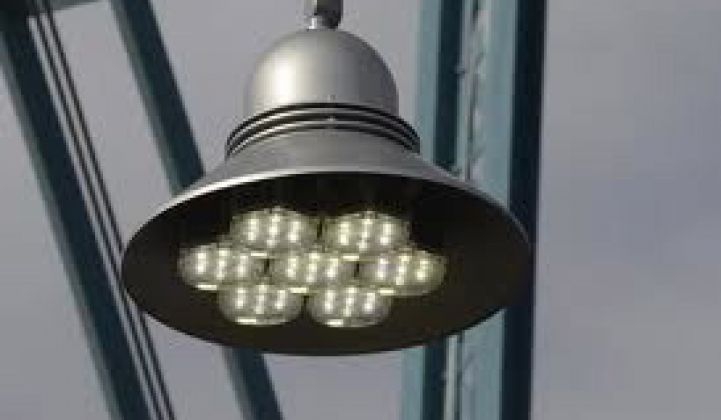Smart meter maker Sensus is expanding to smart streetlights, and it just got its first citywide project in Chattanooga, Tenn. That’s where city utility EPB and hometown LED maker Global Green Lighting are installing 27,000 streetlights that can be remotely lit, turned off, dimmed or flashed in patterns, all from a utility’s central command center or the laptop in a police car.
Networked streetlights are nothing new, but using a smart meter network to control them is. Indeed, Sensus has made a goal of expanding its AMI reach to distribution sensors and automation devices that need fast and reliable communications to make up their share of the smart grid. Expanding to streetlights could open up a big new market.
The vast majority of the world’s streetlights are both dumb and energy-wasteful. Networking them adds costs -- Chattanooga’s 27,000-streetlight project is expected to cost about $18.5 million, Don Lepard, president of Global Green Lighting, told me in a Tuesday interview.
But it’s also expected to save $2.7 million a year in energy and maintenance costs, adding up to a smart payback for a municipal project, Charlie Nobles, Sensus product manager for lighting, said Tuesday. While he wouldn’t discuss project cost, he did note that Chattanooga’s EPB doesn’t use Sensus for its smart meters, meaning that the company had to deploy the towers and backhaul to manage the streetlights from scratch.
Existing Sensus AMI customers, such as major Southeast utility Southern Co., might find the incremental costs of adding streetlights to their electric, gas and/or water metering network much lower, he noted. Though he wouldn’t name names, Nobles did say that Sensus was talking with other customers about it.
Lepard told me that Sensus and Global Green Lighting have a 10-year commitment on streetlights, and mentioned that the two are working with the city of Baltimore, Maryland, which is contemplating a project aimed at improving safety in high-crime areas, he said.
Public safety was also the goal of the 350 Sensus-networked LED streetlights that Chattanooga installed in a crime-ridden park last year. Since then, it has seen crime drop sharply under the bright lights and police-controlled spotlighting capabilities that the system provides, Mark Kiel, the city’s information services director, said.
At the same time, the LEDs' energy efficiency and longer lifespan have yielded an immediate $1 million per year energy savings, cutting bills roughly in half, Kiel said. Another $1.7 million dollars per year are expected to come from reduced maintenance costs -- no more driving around looking for burned-out bulbs, or replacing the sunlight sensors that now tell most streetlights when to turn on and off.
The same fundamental efficiency premise is driving a multi-billion dollar expansion in LED street lighting, with big players like Cree or Philips’s Lumileds division, as well as startups like Bridgelux and EcoFit, jumping into the market.
But adding networked services -- the ability to dim lights in unused areas and brighten them when people walk by, or to set daylight schedules remotely -- has shaved an additional 32 percent from streetlight energy bills, Kiel added. Just as importantly, it was the ability to brighten and flash lights to prevent crime.
Very few streetlights are networked today, largely because they need to be upgraded to LEDs first. Today’s high-pressure sodium and metal halide streetlights take minutes to warm up, making control less useful. Still, we’re seeing projects going forward. Echelon, the smart grid and smart buildings technology company, has also networked thousands of streetlights in Europe and Asia, using its powerline carrier technology, for example.
But Sensus’s point-to-multipoint network, running on licensed spectrum, is a lot different than a dedicated wire-line control system like Echelon provides. Sensus is also different than the mesh-based smart meter deployments of competitors like Elster, Itron, Landis+Gyr and Silver Spring Networks, which rely on each meter passing messages down the line to a collector to get news across -- not a guarantee of real-time controls.
That’s more important when you’re trying to demonstrate how fast police can turn up the lights on fleeing criminals, or flash lights to lead emergency responders to the scene of an accident. It’s less so when you’re talking about sunrise-sunset dimming and brightening schedules and other easily preset functions.
At the head end, Sensus is hosting this application in the cloud, Nobles said, giving utilities or cities a lot of choices in how to interface with it, including the aforementioned police laptop examples. The partners are training Chattanooga’s 911 operators now on the map-based interface they built for the city, Lepard said.
As part of its move toward IP-capable platforms, each FlexNet radio-equipped streetlight has its own IP address, Nobles added. Pretty much every major smart meter vendor has embraced IP to one extent or another, though some -- like Itron’s partnership with Cisco -- could be considered “more IP” than others.
Add streetlights to the growing list of things that the “internet of things” will be connecting someday.



